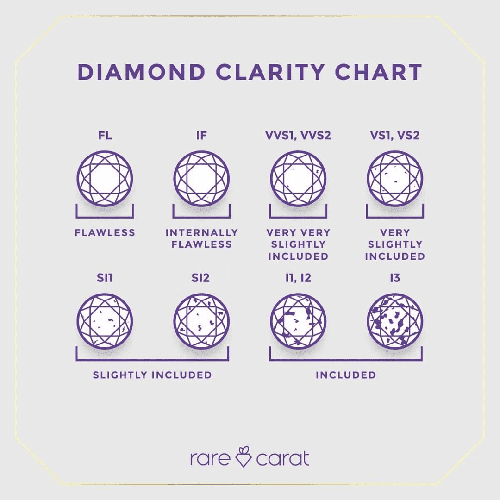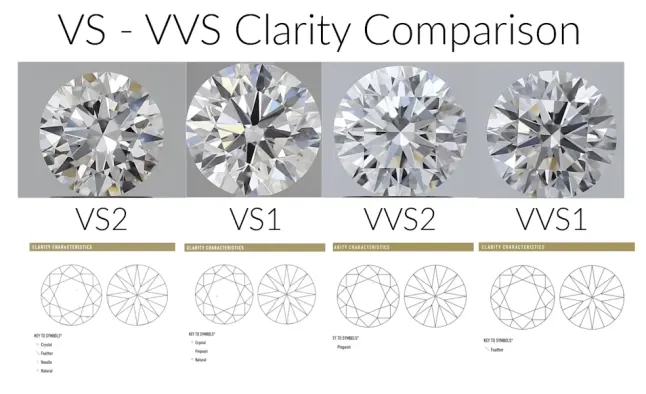What is VVS? & VVS Diamonds vs. VS Diamonds Buying Guide.
A comparison of VVS and VS diamond clarity grades, highlighting their key differences
- VVS (Very Very Slightly Included) diamonds have microscopic inclusions barely visible at 10x magnification
- VS (Very Slightly Included) diamonds show slightly larger but still tiny inclusions
- VVS ranks higher in clarity (VVS1 > VVS2 > VS1 > VS2) and costs more
- Both look eye-clean—VVS offers premium quality; VS gives better value
- The choice depends on budget vs. perfection—both are excellent clarity options
What does VVS mean? VVS stands for "Very Very Slightly Included," which indicates that the diamond has very small inclusions or blemishes that are barely visible, even under 10x magnification.
Diamonds are brilliant sparkly wonders of the natural world… but buying diamonds can feel like an overwhelming, intimidating, or even nerve-wracking process. I mean we are talking about a luxurious, high-priced item after all! The easiest way to become more comfortable in knowing what you are looking for is by learning a little about diamond quality. With that goal in mind, today we are talking about the differences between VVS and VS diamond clarity grades - both of which are impressive quality stones. And while there might be plenty of other diamond features to learn about later on - this is a really great place to start! Let’s talk diamonds!
Diamond Clarity Scale

Seeing where our VVS and VS diamonds rank on the clarity scale can really help in understanding the high level of clarity we are dealing with here.
- Flawless (F): This is the top tier, rarest, highest priced diamond - basically as perfect as something can naturally be.
- Internally Flawless (IF): As perfect as a flawless diamond on the inside, but will have a blemish or two on the outside. IF diamonds can be recut to become (slightly smaller) flawless diamonds.
- Very Very Slightly Included (VVS1, VVS2): This is our first level of clarity that will have any kind of inclusion at all. And by any kind, I mean the tiniest, teeniest, most minute inclusions that can barely be seen - even under high power magnification.
- Very Slightly Included (VS1, VS2): At this level of clarity, the inclusions are slightly larger but are still only visible under magnification. Eye clean and fabulous!
- Slightly Included (SI1, SI2): Being a slightly included diamond means the inclusions become more visible…and often at this level, these inclusions can be seen without magnification (which may or may not be distracting).
- Included (I1, I2, I3): I think the name says it all - included diamonds have many large, obvious inclusions that can absolutely be seen when just looking at the stone.
VVS Diamonds vs VS Diamond Quality
Let me go ahead and reiterate that the quality of both of these clarity grades is phenomenal! But undoubtedly, VVS diamonds are the higher quality of the two. And, to dive even deeper, VVS1 is better than a VVS2. The differences between VVS1 and VVS2 diamonds are based on where the inclusions are located (like front and center or off to the side and hidden), how many are present, how dark or obvious the inclusions happen to be, and what the inclusion actually is (such as a pinpoint vs. a feather). This is also true for the differences between the other level 1 vs. level 2 diamond clarity grades.
So, to simplify, VVS1 is the highest quality of VVS diamonds and VS clarity diamonds. In fact, the only diamonds that would even rank superior are the ones without any inclusions at all (aka flawless and internally flawless)… and there are not that many perfect gems just floating around in the world! I love all diamonds but if you own a VVS1 diamond - that is definitely something to be proud of!

Price
The price of a diamond depends on a few things - the 4C’s to be exact. The color, cut, carat weight, and of course - clarity, are all influential in the overall value of a diamond. In general though, the higher the level of clarity and the bigger the diamond, the more expensive the diamond will be. Large, inclusion free diamonds are rare, and the price tag will reflect that. This is why our VVS1 stones (of comparable sizes) will almost always be the most expensive diamond among our VVS diamonds and VS diamonds.
Which is Better?
I am sure by this point you can probably guess, but the VVS diamond is the overall better quality gem… and you will be paying for that high level of excellence. If your priority is a great clarity (and bragging rights) definitely go for the VVS! But if you are looking for a slightly larger diamond and are okay with a lesser (yet still high) level of clarity, choosing a VS diamond might be more for you. Basically, what I am trying to say is - whichever works best for you is better! There is no right or wrong diamond!
Differences Between VVS and VS Diamonds
To sum it up, I have taken everything we now know and organized it into an easy reference list…
VVS diamonds rank higher on the clarity scale: which means their clarity quality is better than VS diamonds. The cleaner the diamond, the more extraordinary it is.
V.V.S. diamonds are rarer: and the rarer and closer you get to perfect, the more valuable and expensive the gemstone becomes.
VS diamonds have larger inclusions: even with that being true, we are still talking basically smaller than specks of dust here people!
VS diamonds are less expensive: because VS diamonds are a slightly lower clarity and are somewhat more common, VS diamonds will cost less than comparable VVS diamonds.
VVS diamonds are overall superior to VS diamonds: but at these two clarity levels, the inclusions are all microscopic - meaning you won’t be seeing them (unless you happen to be a trained pro with magnification). Every one of these diamonds is going to be eye clean - and that is the ultimate goal!
Listen, if your big decision in life is trying to choose between a VVS or a VS diamond, you are winning my friend! Really it mostly comes down to quality, budget, and preference…with no wrong decision possible. So, with that in mind, you can relax and just enjoy the diamond buying process (because buying diamonds should always be fun!).
Not sure VVS or VS diamonds are right for you? Read more about other options and ideas below:
- What are SI1 (Slightly Included 1) clarity diamonds?
- The Essential 4 C’s of Diamonds
- How to Choose Diamond Pairs for Diamond Earrings


VVS vs. VS Diamond FAQs